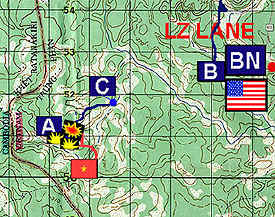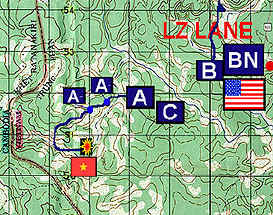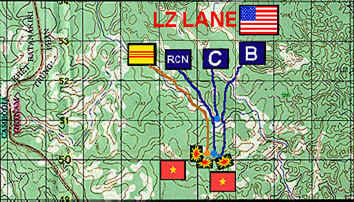
HOME
From the 1/14th Daily Journal for 19 NOVEMBER 1966.

19 NOVEMBER 1966 Although the heavy contact with NVA troops on the 13th of November was still fresh in the minds of the men, today they would relive this struggle with an even more determined and large enemy force. Innumerable incidents of personal heroic actions, and the valiant fighting team spirit of out units brought us through on top. Every man who faced the enemy did so in an outstanding manner, and reflected nothing but the highest credit on the Golden Dragon tradition. Company B planned to patrol on an axis parallel to our attached CIDG personnel from Plei Me to LZ "Rio" and then south to the previously discovered bunker complex. Lt. Col. Procter, knowing that such a complex existed so near to LZ Lane, was determined to destroy it. In the vicinity of the bunker complex, a LZ was to be cut so that an Engineer Platoon could be helilifted in to destroy the heavily fortified area. Company B was to act both as a security force for the Engineers and a reaction force for the sweep of Company C and the CIDG Company to the south and west of the bunker complex. They would then close back to LZ "Rio" during the night of 18 November. Their plan was to patrol south to the bunker complex in front of Company B and the CIDG Company. With one squad of engineers that accompanied them, Company C was to initiate the clearing of a LZ near the complex. After Company B and the CIDG Company closed into the bunker area, Company C was to patrol in conjunction with the CIDG to south, west, and then to the north, back to LZ "Rio". They were to go to within 1 1/2 Km of the Cambodian-Vietnamese border, keeping the CIDG on their right flank as they made a sweep clockwise around the bunker complex.
The CIDG Company planned to patrol on an axis parallel to Company B to LZ "Rio", and then south to the bunker complex. From the bunker complex they planned to patrol on an axis parallel and on the right flank of Company C, in their sweep of the area around the bunker complex.
The Recon Platoon was attached to the CIDG Company and planned to work with them.
The movement went as planned during the morning of 19 November 1966. Company C moved out to the bunker complex with Company B and the CIDG moving up behind two axis. Soon Company C reached a fairly open area and broke for chow while Company B and CIDG moved through them toward the bunker area. The CIDG were on the West, Company B was on the east and the Recon Platoon was in the center as they moved south.
At 1207 hours, Company B's right flank began to receive small arms fire and grenades from the Southeast at YA605500. Shortly thereafter, the "point" of the CIDG began receiving heavy automatic fire from the front and right flank. The point fell back and the rest of the Company immediately came up on line. This put Company B, Recon and CIDG on line in that order from east to west.
The entire line began to advance under heavy small arms fire and were hit extremely hard from the west, on the Recon Platoon's right flank. Company B was also receiving heavy fire from the front. Col. Procter decided to use Company C as the maneuver element and move them up on the west to come in on the Recon Platoon's right flank and relieve the pressure.

Company C started to move up from the west when they were hit hard and were slowed considerably in their advance. The enemy occupied positions in the bunkers as well as covering all approaches and dead space by well-concealed snipers. The enemy force at times looked like walking trees due to the expert use of natural foliage to conceal themselves. The Recon Platoon, most heavily engaged, found themselves butt stroking and bayoneting fanatical enemy troops. The NVA were individually maneuvering and twice charged the Recon Platoon and were twice repelled.
The Dragon machine gunners were ripping the trees to shreds looking for the well-concealed snipers. The enemy force controlled their fire proving that they were a well-trained and disciplined unit. Our men fought for their fallen comrades.
The evacuation of the wounded became extremely hazardous, but was carried out w1th extreme courage. A force, including Pfc Miles D. Cooper, was mustered when it became necessary to evacuate the seriously wounded in Co B. Displaying great devotion to his men and his unit, and with complete disregard for his own personal safety, he provided covering and suppressive fires long after the evacuation force had withdrawn. While attempting to withdraw himself, he was shot and killed by a hidden sniper.
Specialist Four Dwight L. Basey, A member of the 3rd Platoon, Company B, while personally carrying casualties from the perimeter was shot from an enemy position. Disregarding his wound, he continues to advance under fire to retrieve fallen comrades from exposed positions. While attempting to resupply a machine crew, death overcame him.
Specialist Four Robert G. Rudolph, an RTO in the 1st Platoon, Company B, while attempting to maintain inter-company communications, was also shot and killed by an enemy sniper.
Specialist Four Michael B. Swangin, a gunner in the 3rd Platoon, Company B, while maintaining a commanding firing position, was shot and killed while giving suppressive fire for the evacuation force.
The Recon Platoon contributed to a huge number of the acts of heroism during the intense 6-hour ordeal. Specialist Four Herbert Carson Shupe and Company C's Robert Serrano, both medics, while tending the wounds of Capt. Audley M. Federline, were both shot to death by direct automatic weapons fire.
SSgt Jesse L. Harris was immediately wounded while leading his men in an assault on a series of well-concealed bunkers. While receiving aid from one of the other members of his team, he was shot again and died in the arms of his men.
Specialist Four Lewis R. Kirby and Pfc James Ohlinger, while acting as point men in the aggressive assault, were killed instantly by an incoming mortar round.
Pfc Gregory Bielicki, while laying an extremely effective base of fire down for the assaulting team, was shot and killed by a sniper.
Specialist Four Frankie L. Priest was cut down by a machine gun while attempting to bring his radio up to the squad leader.
Specialist Four Edmund V. Dlugokinski and Pfc James Kennard were both killed by machine gun fire while attempting to retrieve a fallen comrade.
Company C's acts of valor included Sgt. Ted Belcher's falling on an enemy grenade; Ssgt Robert Machado and Pfc Joseph McCown trying to aid the torn soldiers, were both cut down by enemy snipers. Capt. Audley M. Federline, Company Commander of Company C, was wounded in the chest by an enemy sniper. Later that night, this new but highly distinguished officer died of the wound. After the wounded and dead were evacuated, all three companies pulled back to an LZ and spent the night.
The enemy accounted for the death of a total of 18 Golden Dragons; however, the Golden Dragons killed an estimated 280 enemy troops and 166 of their bodies were left in the field. The day was a hard fought battle in which the Dragons, once again, proved themselves too much for the enemy to handle. The enemy force the men encountered was believed to be two battalions from the 33rd Regiment, LE LOI Division. None of the Dragons will ever forget this savage fight or any of their fallen comrades.
There were men awarded the Distinguished Service Cross in this action:
1 Lt Frank G Primmer HHC
Sp4 Ronald K Westfall HHC
PSGT Wm J Wickward HHC
Wickward was later killed during another tour,
8/27/69 with the 1st Division.Webmaster's Note:
Dwight Basey was killed on Nov 19th but under different circumstances than described. He spent some time assisting wounded but was a machine gunner along with Michael Swangin, his loader. During the middle of the fight Basey and Swangin brought their machine gun up on line next to me. We were in danger of being overrun and both placed themselves in the line of fire from the VC in order to assist us. After only 2 to 3 minutes of firing at the VC at close range, both were hit by automatic fire from the same burst. Both were mortally wounded. I retrieved their gun and someone else continued the machine gun fire at the VC. I believe that their getting that gun on line was instrumental in our ability to defend that section. This is a small correction after all these years, but I appreciate your doing what you can on this . I know we can't change the official record but these guys were something of a hero that day so I want it as accurate as possible.
Submitted by Alan Quale, B Co., 1st Bn, 14th Inf.




